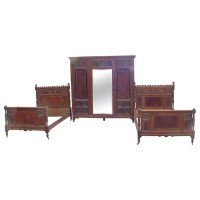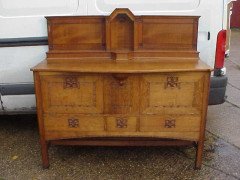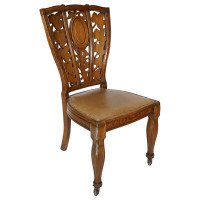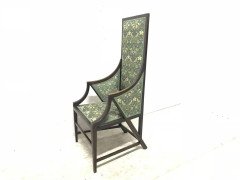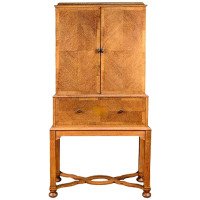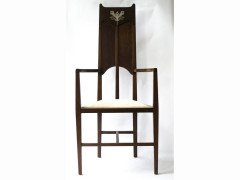Bruce Talbert for Gillows. A rare and important walnut, amboyna, ebonised and gilt bedroom suite
POA
Bruce Talbert (1838-1881) for Gillow and co. A rare and imprtant plain walnut, amboyna, ebonised and gilt bedroom suite, each with differing carved rosettes, comprising: a triple mirror door wardrobe, 208cm high, 208cm wide, 58cm deep; a pair of bedside lockers, 85cm high, 38cm wide; and a pair of single bedsteads, 124cm wide Provenance: The famous Argentinian writer and suffragette Victoria Ocampo (1890-1979), bought from her estate and shipped back from Argentina. Bruce James Talbert originally trained as a carver then an architect, he became an influential and very successful furniture designer. He served an apprenticeship in Dundee and had his own carving business for two years where he learnt the skills to apply carved details to furniture and then joined the architectural offices of Charles Edward. In 1856 he moved to Glasgow. And worked for the architects W. N. Tait and Campbell Douglas. He moved to Manchester in the early 1860s, where he gained employment with the cabinetmakers Doveston, Bird and Hull, which was short lived, then moving to to Coventry gaining work with Skidmore's Art Manufactures. In 1863 he won the competition to design the masthead for 'The Building News' and in the mid 1860s moved to London, where he started designing furniture for Holland and Sons. His 'Pericles' Gothic sideboard was displayed on their stand at the Paris Exposition Universelle of 1867 where it was Grand Prix winner. It was at this point that his most prolific period began and also when he started designing furniture for Gillows of Lancaster from 1868. in the same year he published his very influential first book 'Gothic Forms Applied to Furniture, Metal Work and Decoration for Domestic Purposes', which he dedicated to George Edmund Street. This was followed in 1876 by 'Examples of Ancient and Modern Furniture, Metalwork, Tapestries and Modern Furniture' and in 1881 by 'Fashionable Furniture'. Other companies he designed for were Marsh, Jones and Cribb, Jackson and Graham and a short time, was a partner with Daniel Cottier. He designed textiles for Templeton's, Warner's, Cowlishaw and Barbour and Miller; carpet designs for Templeton's and Brinton and Co.; and his wallpaper designs were printed by Jeffrey and Co. He also designed church metalwork and furniture for Cox and Sons, cast iron for the Colebrookdale Co., Nichol and Co., Barbone and Miller and Cowlishaw. In 1869 Talbert returned to London working as prolific and successful freelance commercial designer and decorator.


